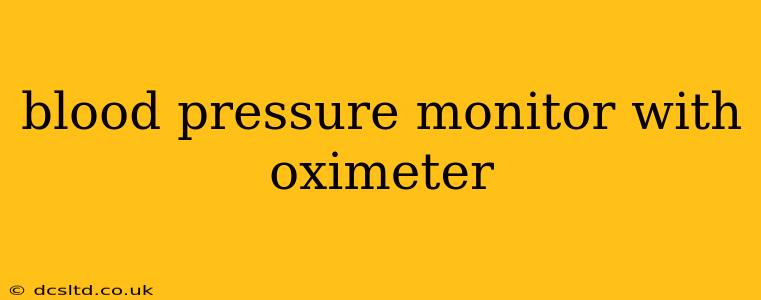Monitoring your health at home has never been easier, thanks to the convenience of combined blood pressure monitors and oximeters. These devices offer a powerful combination of features, allowing you to track both your blood pressure and blood oxygen saturation (SpO2) levels, providing valuable insights into your cardiovascular health. This guide will explore the benefits, features, and considerations when choosing a blood pressure monitor with an integrated oximeter.
What is a Blood Pressure Monitor with Oximeter?
A blood pressure monitor with an oximeter is a dual-function device that measures both your blood pressure (systolic and diastolic readings) and your blood oxygen saturation (SpO2). Blood pressure measures the force of blood against your artery walls, while SpO2 indicates the percentage of oxygen-saturated hemoglobin in your blood. This combined monitoring provides a more comprehensive picture of your cardiovascular health than either measurement alone. Many models are wrist-worn for ease of use, while others are cuff-based like traditional blood pressure monitors.
Why Choose a Blood Pressure Monitor with an Oximeter?
The key benefit lies in the combined readings. While high blood pressure is a significant health concern, low blood oxygen saturation can also indicate underlying respiratory or cardiovascular issues. By monitoring both, you gain a clearer understanding of your overall health status and can identify potential problems earlier. This is particularly useful for individuals with:
- Heart conditions: Monitoring both blood pressure and oxygen levels can help manage conditions like heart failure or arrhythmias.
- Respiratory illnesses: Individuals with asthma, COPD, or other respiratory problems can benefit from tracking oxygen saturation levels.
- Sleep apnea: Sleep apnea often leads to reduced blood oxygen levels during sleep, and this device can help identify potential issues.
- Elderly individuals: Regular monitoring can help detect early signs of health problems in older adults.
What Features Should You Look For?
Several features can enhance the usability and accuracy of your blood pressure monitor with oximeter:
- Accuracy and Reliability: Look for monitors with certifications from reputable organizations to ensure accuracy and reliability.
- Ease of Use: A simple interface and clear display are crucial, particularly for older adults or those with limited technical skills.
- Data Storage and Connectivity: Some models store readings and can connect to smartphone apps for easy data tracking and sharing with healthcare providers.
- Display Size and Clarity: Ensure the display is large and easy to read, especially if you have vision impairments.
- Battery Life: Consider the battery life, especially if you plan to use the device frequently.
- Warranty and Customer Support: Check the warranty offered by the manufacturer and the availability of customer support.
How Accurate are Blood Pressure Monitors with Oximeters?
The accuracy of these devices varies depending on the brand and model. It's essential to choose a reputable brand with a proven track record of accuracy. While generally reliable for home use, they shouldn't replace regular check-ups with a healthcare professional. Always consult your doctor to interpret your readings and receive appropriate medical advice.
How Often Should I Use a Blood Pressure Monitor with Oximeter?
The frequency of use depends on your individual health needs and your doctor's recommendations. Some individuals may need daily monitoring, while others may only need occasional checks. Your healthcare provider will guide you on the appropriate frequency based on your specific health condition.
Can I Use This Device for Fitness Tracking?
While some models might offer additional features like fitness tracking, the primary function is health monitoring, not fitness tracking. The data provided focuses on your cardiovascular and respiratory health and not on metrics like steps, distance, or calories burned.
Conclusion
A blood pressure monitor with an oximeter is a valuable tool for proactive health management. By providing a comprehensive view of both your blood pressure and oxygen saturation levels, this device empowers you to take control of your health and identify potential issues early. Remember to consult your doctor to interpret your readings and develop an appropriate health management plan. Choosing the right device involves careful consideration of features, accuracy, and your individual needs.
